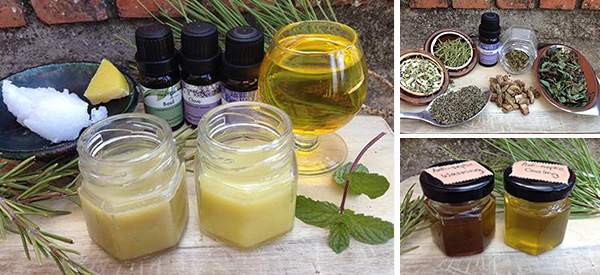
Natural DIY Polysporin Salve Recipe
Most of the time our bodies can deal with the variety of microbes, bacteria, pathogens, and fungi living on our skin, but occasionally the equilibrium becomes unbalanced, and this is when a cut or patch of skin can become infected.
Polysporin is an antibiotic ointment that can target a wide variety of bacteria. This includes bacteria that cause staph (Staphylococcus), strep (Streptococcus), E. coli, bacillus, chlamydia, and pseudomonas infections, just to name a few. So, when making your own Polysporin salve, you should be targeting herbs, plants, and oils that specifically inhibit the bacteria listed above.
Substituting prescription medications with herbal remedies has been found to ease our dependency on antibiotics, and decreases the risk of bacteria and microbes building resistance to them.
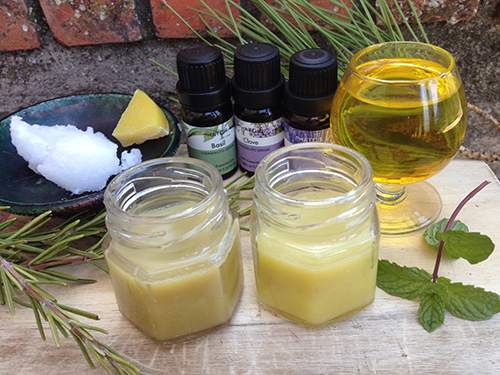
In many situations when treating a bacterial infection, it is usually better to apply an oil-based remedy, as opposed to a cream-based one. This is because bacteria often thrive in damp, moist areas on the body, and since creams are water-based, they provide a perfect breeding ground for bacteria on the skin.
Often an infected wound or scratch can feel warm to the touch. In this situation, a cooling salve will provide the most relief. Other times, warming, the cleansing salve is preferred, so below you will find two salve recipes: one warming and cooling.
Recipe 1: Warming Anti-Septic Salve
- Rosemary is anti-bacterial and anti-inflammatory and breaks down the cell’s walls of foreign microbes to make treatment more effective. It also has antioxidants, which is good for protecting the skin.
- Basil kills a large variety of bacteria and fungi with similar results to pharmaceutical medications. Its medicinal compounds are highest in the fall and beginning of winter, so this is the ideal time to harvest it.
- Cinnamon essential oil and the closely related cassia oil are one of the most effective herbs for killing drug-resistant Pseudomonas and E. coli.
- Clove (Syzygium) is one of the most effective herbs at treating a wide range of drug-resistant bacterial infections including E. coli, Pseudomonas, and chlamydia.
- Lavender is anti-bacterial and minimizes staph and E. coli infections that are resistant to prescription medications. It can also reduce the itchiness that’s associated with wound healing. It is an adaptogen, so it can be added to both warming and cooling remedies.
- Oregano (Oreganum Vulgare) is incredibly versatile, and it too has numerous medicinal qualities; anti-bacterial, anti-fungal, anti-microbial, anti-oxidant, and anti-inflammatory. It is effective against resistant strains of E. coli, pseudomonas, chlamydia, and staph, and is also an adaptogen.

Some other warming herbs and adaptogens that have similar cleansing properties include;
| HERB OR PLANT | MEDICINAL PROPERTIES |
| GARLIC | Anti-bacterial, anti-fungal, kills staph and E. coli |
| PERU BALSAM | Anti-bacterial, kills pseudomonas |
| MILK VETCH | Increases immune response |
| CHAMOMILE | Anti-bacterial, anti-fungal, kills staph and E. coli |
| CAT’S CLAW | Anti-inflammatory, anti-bacterial, anti-fungal, anti-viral, boosts the immune systems response |
| YARROW | Anti-bacterial, anti-viral, stimulates circulation |
| BLACK-JACK / SPANISH NEEDLE | Anti-bacterial, anti-fungal, anti-inflammatory, do not take while pregnant. |
Recipe 2: Cooling Anti-Septic Salve
- Peppermint is anti-microbial, anti-bacterial, and anti-viral. It has been shown to kill resistant bacteria including staph.
- Pine needles, bark, and resin have various medicinal qualities, including being antiseptic, anti-bacterial, and anti-fungal. It has been shown to be effective against drug-resistant staph and it is thought to draw toxins from the body.
- Thyme (Thymus vulgaris) kills pseudomonas that is resistant to medications by destroying their protective biofilms. It also increases circulation which accelerates healing.
- Burdock (Articulum) is considered a weed in many parts of the US, but research has shown that the oil from its root has the ability to kill the biofilm around certain bacteria. It is also an antioxidant and anti-inflammatory. You should avoid burdock if you are allergic to inulin.
- Echinacea boosts your body’s resistance and immune response as well as killing certain types of yeast and fungi. It is also anti-inflammatory and reduces scarring.
- Lavender is anti-bacterial and minimizes staph and E. coli infections that are resistant to prescription medications. It can also reduce the itchiness that’s associated with wound healing. It is an adaptogen, so it can be added to both warming and cooling remedies.
- Oregano (Oreganum Vulgare) is incredibly versatile, and it too has numerous medicinal qualities; anti-bacterial, anti-fungal, anti-microbial, anti-oxidant, and anti-inflammatory. It is effective against resistant strains of E. coli, pseudomonas, chlamydia, and staph, and is also an adaptogen.
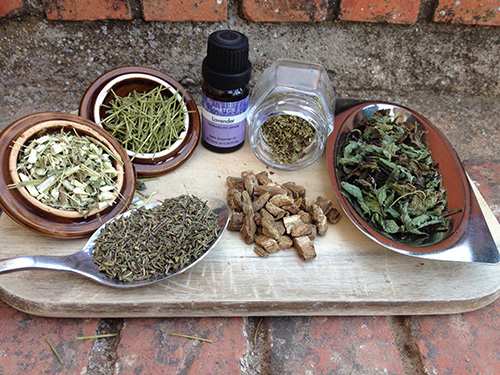
Some other cooling herbs and adaptogens that have similar cleansing properties include;
| HERB OR PLANT | MEDICINAL PROPERTIES |
| SKULLCAP | Anti-bacterial, anti-inflammatory, kills E. coli and staph |
| EUCALYPTUS OIL | Anti-microbial, kills certain types of bacteria |
| TEA TREE OIL | Anti-inflammatory, antibiotic, anti-septic and anti-fungal |
| GOLDENSEAL | Increases immune response |
| PAPAYA / PAWPAW | Anti-bacterial, anti-fungal |
| CAT’S CLAW | Anti-inflammatory, anti-bacterial, anti-fungal, anti-viral, boosts the immune systems response |
| YARROW | Anti-bacterial, anti-viral, stimulates circulation |
| BLACK-JACK / SPANISH NEEDLE | Anti-bacterial, anti-fungal, anti-inflammatory, do not take while pregnant. |
Carrier Oils
Coconut oil improves and repairs the skin barrier which minimizes the likelihood of microbes penetrating into the skin. In addition to this, it is also anti-bacterial, and is particularly effective during the winter months for moisturizing the skin thanks to its high concentration of fatty acids. It is these fatty acids that result in coconut oil taking slightly longer to be absorbed into the skin, and for this reason, try mixing coconut oil with olive oil in equal parts for this herb-infused oil. The olive oil maintains the elasticity and moisture of the skin, with the added benefits of being anti-bacterial and anti-inflammatory.
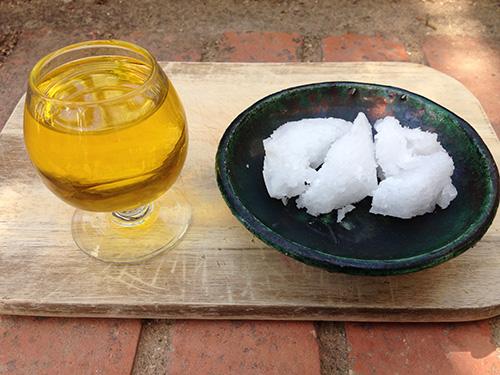
Since coconut oil is a solid at room temperature, the solar method for infusing herbs into a carrier oil is not as effective as the double boiler method, which is outlined below.
As we edge closer to the winter months, a salve that contains both coconut and olive oil will help to fight off skin infections and maintain healthy skin.
Method:
Below are 2 simple steps you can follow to make your own antiseptic salve.
The first step involves infusing the carrier oil with the dried herbs that you have selected from the list above, and the second step combines the infused oil with beeswax and essential oils.
Step 1: Natural DIY Polysporin Salve Recipe – Herbal Infused Oil
- Decide whether you are making warming or cooling salve, and select your dried herbs from the appropriate list above.
- Place a jar in a pot of warm water (approximately 100 °F) and add about half a cup of coconut oil to the jar and wait for it to melt before adding half a cup of olive oil (this will make approximately 1 cup of infused oil).
- Add about a tablespoon of each herb into the jar, ensure all of the herbs are covered by the oil mix and screw the lid on tightly so that no steam or water can get in.
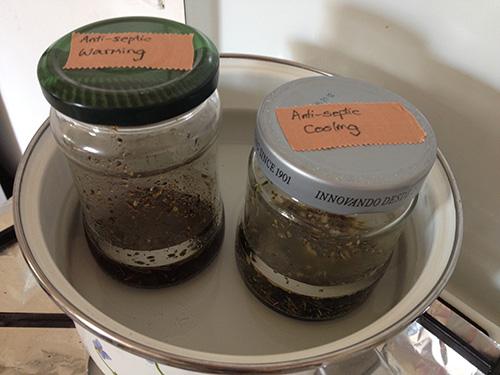
- Leave the jar in the pot of warm water for at least 3 hours, shaking every 30 minutes or so. You can tell when the infusion process is complete because the oil will change color and will acquire the aroma of the herbs.
- Strain the oil and label it. If you are using ground herbs, such as cinnamon, you can either strain it through a coffee filter or allow any solids to settle to the bottom and decant the cleaner oil off the top. With the addition of olive oil, the infused oil should remain a liquid at room temperature. Now you are ready for step 2.
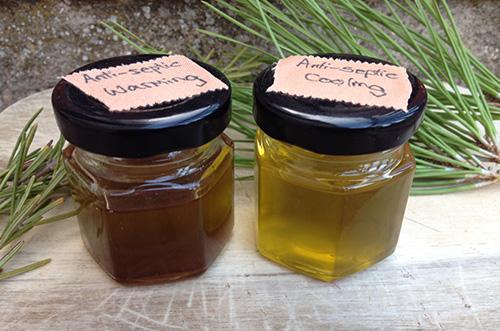
Step 2: Natural DIY Polysporin Salve Recipe
- Place a jar in a pot of warm water (no more than 150 °F) and add about half a cup of the infused oil from step 1 (this will leave you with half a cup of infused oil to store in the cupboard for another remedy later in the year).
- Now you can add the beeswax. The ratio for oil to beeswax is approximately 5:1. So for every 100 grams (or half cup) of oil you use, you should add about 20 grams of beeswax to the jar and stir until the beeswax has melted.
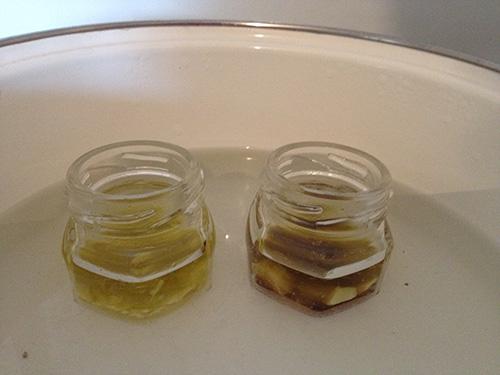
- Test the consistency with a cold spoon. If it is too soft, then add more beeswax. If it is too hard, simply add more infused oil.
- Add a few drops of essential oil and stir. In my case, I add a few drops of clove, basil, and lavender essential oil for the warming salve; and lavender to the cooling salve.

- Remove the jar from the pot of warm water and allow it to cool slowly to solidify (the slower you cool the salve, the less chance of it cracking or sinking on top).
Apply the salve liberally to the infected area 3 times a day until the wound has healed.
You may also like:
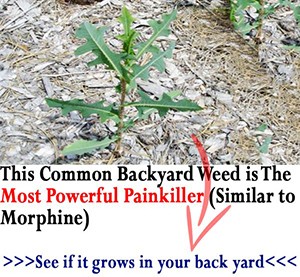 10 Natural Antibiotics You Can Find in Your Garden
10 Natural Antibiotics You Can Find in Your Garden
An Ingenious Way to Stockpile Prescription Medicines (Video)
4 Natural Antibiotics that Can Replace Over-the-Counter Drugs








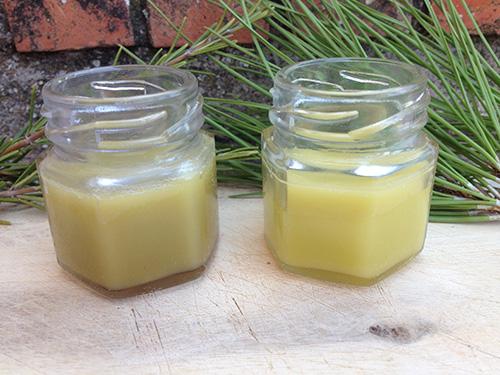
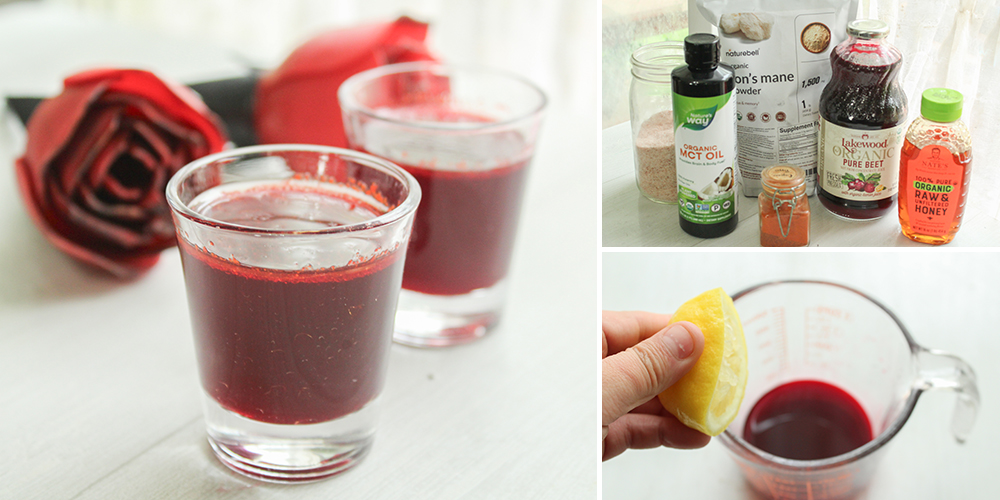
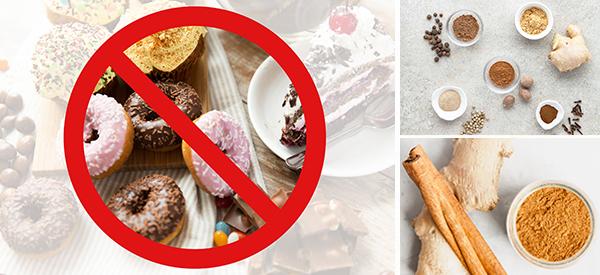
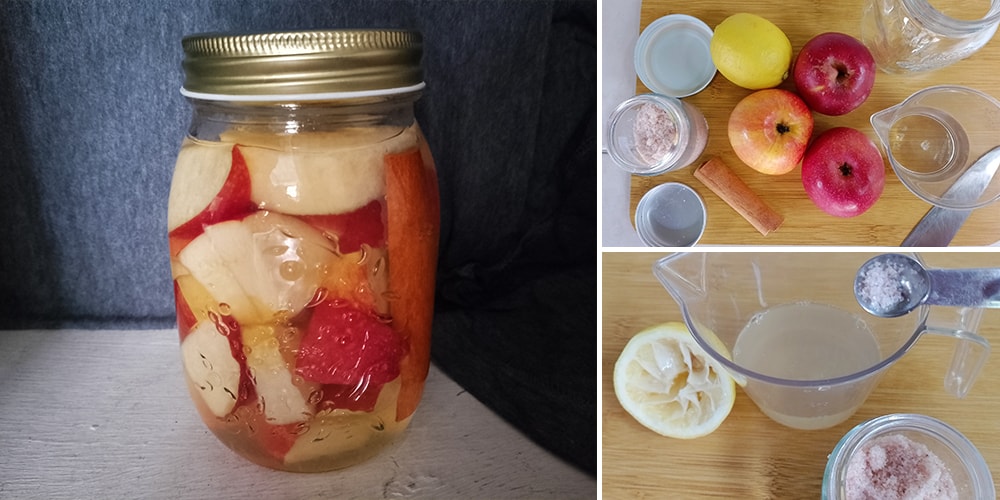
AWESOME article today!
Hi Mary,
Thank you for your comment.
We are glad to hear you liked our article for today!
God bless!
Love this! I need a good recipe for a face cream. Any ideas? I want to use argon oil and beeswax
Hi Alice,
Thank you for your interest in our work.
You can try this simple recipe:
INGREDIENTS
1/2 cup shea butter
2 tablespoons organic coconut oil
2 tablespoons organic extra-virgin olive oil
Optional: 20 drops of essential oils (based on skin type)
God bless!
Thanks very much reading your book I just ordered .
Please I will like to ask if I can use only essential oils and bees wax for this recipe without making my own oil blend .If so how many drops of each oil? Thanks again for this great information
Adding beeswax will make it way too hard…..you don’t need beeswax for a face cream.
Great article! Can’t wait to make some of these.
Might you know anything about herbal medicine for cats? I’ve asked several vets and they have no information nor could they refer me to someone who did.
I would appreciate any help you could give.
Hi Pam,
Thank you so much for your comment.
We are glad you liked the article.
You can find more information about natural remedies for cats in the link below:
https://thelostherbs.com/herbal-remedies-for-pets/
God bless!
Will be making these
Hi Steve,
Thank you for your interest in our work.
Tell us how it goes.
God bless!
Wonderful! I’ll be trying it. I don’t have beeswax though. I do have left over Shea butter, coca butter from soap making…will either of those work as a replacement in the second step?
Hi Cindy,
Beeswax is a wax while Shea butter is an oil.
Soy wax is all-natural and can serve as a substitute for beeswax.
But you Shea Butter and Cocoa Butter are good substitutes as well. They are used all the time for preparing vegan products.
God bless!
If allergies to beeswax prevent using that, what other wax would you use?
Hi Nicole,
Thank you for your comment.
You can replace beeswax with:
1. Soy Wax: While most commonly used in candles, soy wax can also be used as a replacement for beeswax in cosmetics and personal care products such as this natural deodorant.
Soy wax has the same hardness as beeswax so it can be used in equal amounts in recipes.
2. Candelilla Wax: has the same lubricating properties as beeswax but is harder and much less pliable. Use half the amount called for when substituting for beeswax.
God bless!
Great article and I will be making to have on hand! When I got the Lost Herbs book, I didn’t realize I would be blessed with all the added recipes for healing. Thank you!
Love this. Tad late for my leg after a fall but will make for future use. But don’t want to fall again. What is the shelf life for the salve?
Hi Janey,
We are sorry to hear about your leg.
Your DIY salve will keep for up to 12 months stored in a cool, dark spot.
God bless!
This recipe sounds great, I will be making some soon. I am a bit of a klutz and am always hurting myself. I also get infections fairly easily. This will be great to have on hand. Thank you!
What happens if one is allergic to coconut? I get serious migraines when I consume or use
Coconut. Is there an alternative I can use?
Can you suggest an alternative essential oil to use instead of clove, in your warming recipe? I know that it’s an amazing oil, but it gives me terrible headaches. Thank you!
Hi again, will you verify which kind of eucalyptus essential oil (globules, radiate, etc) and which kind of chamomile essential oil (Roman, German, etc) are lists in the above lists. I know that they have different properties, and I want to make sure that I have the correct chemotype. Thank you.
Actually, the correct ratio of oil to beeswax for any salve is 4:1. 4 parts oils, 1 part beeswax. So if you are using 1 cup of oils, you need 1/4 cup of beeswax. This creates the best hard/soft ratio for spreading it without stretching the skin if it is too hard.
I left out the blog post that explains this:
https://www.heartlifeholistic.com/post/beeswax-to-oil-ratios-for-salve
Such great information. Thank you so much. It makes me so happy! Suzanne